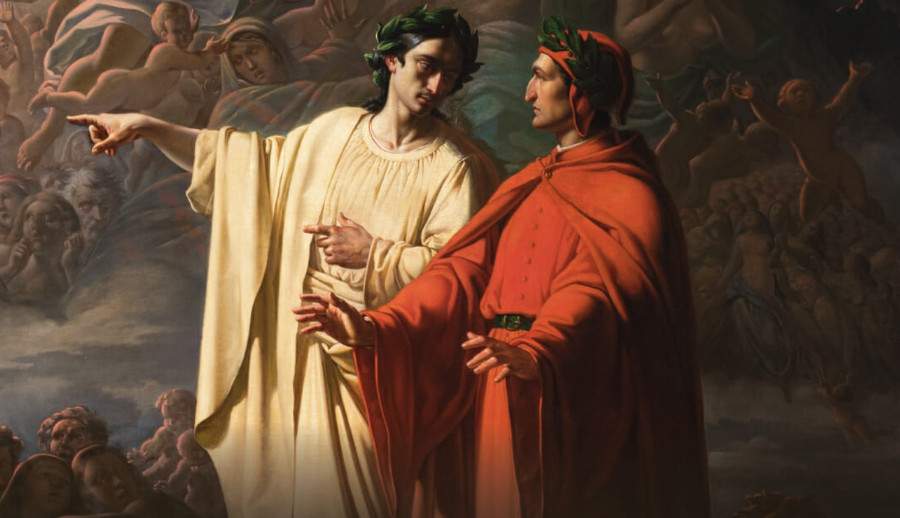The Royal Palace of Naples is celebrating the seventh centenary of Dante Alighieri ’s passing with the exhibition Dante at the Royal Palace, open to the public from Dec. 3, 2021 to March 1, 2022 and curated by director Mario Epifani and Andrea Mazzucchi, produced in collaboration with the University of Naples “Federico II.” On display are three canvases, depicting episodes from the Divine Comedy, completed by painter Tommaso De Vivo for the King of Italy Victor Emmanuel II in view of the centenary of Dante’s birth celebrated by united Italy in 1865 and subsequently divided between the Royal Palace, the National Library and the Royal Palace of Caserta. De Vivo’s cycle has now been exceptionally reunited in its original location after careful restoration and compared with other evidence of Dante’s fortunes in Neapolitan art around the midnineteenth century, from Domenico Morelli’s famous painting depicting Dante and Virgil in Purgatory (1844) to Antonio Manganaro’s album of lithographs illustrating in satirical tone The Maritime Exposition visited by Dante and Virgil (1871).
The first room displaysDante and Virgil’s Meeting with the Great Ancient Poets in Limbo (Canto IV); in the same room and the next, multimedia installation projects illustrations from illuminated codices of the Divine Comedy on an interactive lectern. In the second room, Tommaso De Vivo’s Purgatorio dialogues with other works on Dante’s subject produced in Naples around the mid-19th century. In 1844 Domenico Morelli won, with a subject taken from the second canto of Purgatory, the competition announced by the Royal Institute of Fine Arts in Naples; the canvas, purchased by the Royal Household, was placed in the Bourbon guest quarters building, now the seat of the Prefecture. Luigi Stanziano ’s painting aligns with history painting, between academicism and Romanticism, in illustrating the legendary episode of the meeting between Dante and Giotto, a year after the Dante celebrations of 1865. The album of lithographs published in 1871 by Apulian Antonio Manganaro illustrates in a satirical tone the first International Maritime Exhibition of Italy, inaugurated in the presence of Umberto and Margherita of Savoy. Imagining himself in the guise of Dante, accompanied by a skeletal Virgil, Manganaro observes the machines, products and inventions on display at the exhibition, amid caricatures of characters of the time: the fortunes of the Supreme Poet lend themselves here to an irreverent reading of current events.
The exhibition is completed by Luigi Stanziano’s canvas depicting Dante in Giotto’s studio and a series of 19th-century vases with portraits of Dante, Petrarch, Ariosto and Tasso belonging to the collections of the Royal Palace. The tour is enriched by multimedia projections created by Stefano Gargiulo, artistic director of Kaos Produzioni, which illustrate, through images from illuminated codices, Dante’s journey to the afterlife.
The exhibition inaugurates a new exhibition space in the area of the so-called Genovese Gallery, a 19th-century link between the Royal Palace and the San Carlo Theater.
Until January 31, 2022, moreover, an iconographic and documentary exhibition can be visited in the National Library, within the monumental complex of the Royal Palace, which offers an opportunity to compare Tommaso De Vivo’s cycle with some illustrated editions of the Divine Comedy.
The exhibition is included in the admission ticket to theHistorical Apartment of the Royal Palace.
For info: palazzorealedinapoli.org
Hours: Daily from 9 a.m. to 8 p.m.
Image: Tommaso De Vivo, Inferno, detail (1863; oil on canvas; Naples, Royal Palace)
 |
| Dante at the Royal Palace of Naples: reunited the cycle of Tommaso De Vivo |
Warning: the translation into English of the original Italian article was created using automatic tools. We undertake to review all articles, but we do not guarantee the total absence of inaccuracies in the translation due to the program. You can find the original by clicking on the ITA button. If you find any mistake,please contact us.